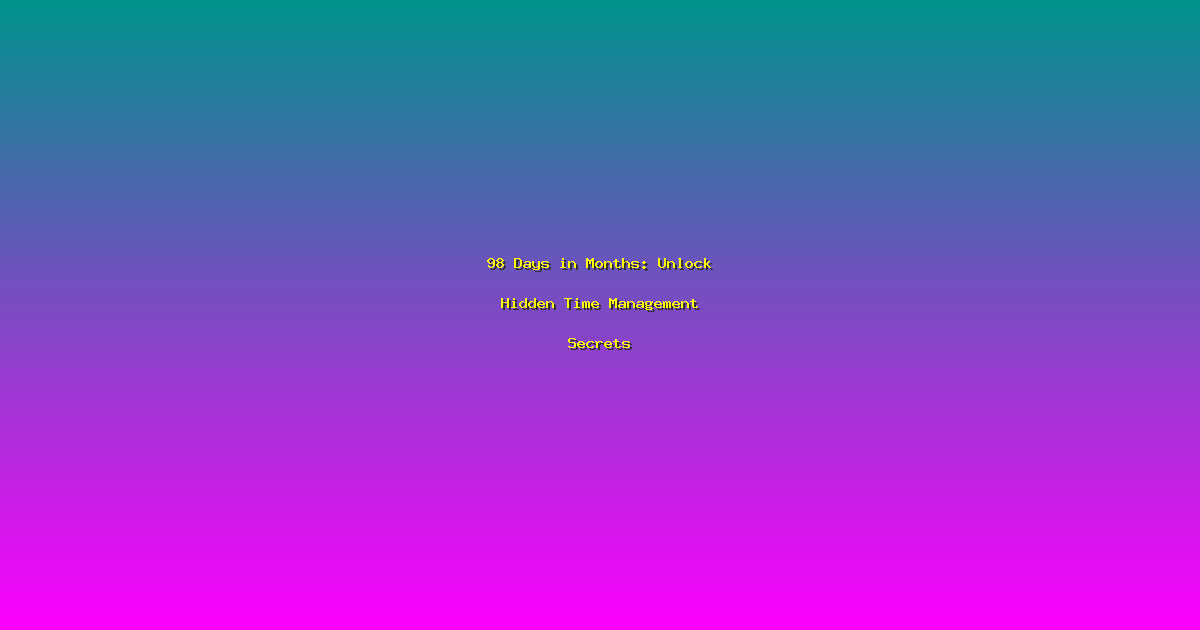98 Days in Months: Unlock Hidden Time Management Secrets
Imagine having the ability to unlock hidden time management secrets that could transform your productivity. Many of us struggle with managing our time effectively, often feeling like there aren’t enough hours in the day. But what if you could harness the power of 98 days in months to make the most of your time? This article will reveal how understanding this concept can help you achieve more in less time. By the end, you’ll have practical strategies to implement immediately, ensuring you make the most of every moment.
Understanding the Concept of 98 Days in Months
The concept of 98 days in months is a powerful tool for time management. It’s based on the idea that by breaking down your year into smaller, more manageable chunks, you can better plan and execute your goals. For instance, if you divide a year into 12 months, each month has approximately 30 days. However, by focusing on 98 days, you can create a buffer for unexpected events and still have a clear timeline for your tasks.
- Key Point 1: The average month has about 30 days, but by focusing on 98 days, you can create a more flexible schedule. This approach allows you to plan for unexpected events and still stay on track with your goals.
- Key Point 2: Real-world example: A project manager at a tech company used the 98-day approach to allocate tasks and deadlines. By doing so, they were able to complete projects ahead of schedule and with fewer delays.
- Key Point 3: Expert Insight: According to Dr. Laura Vanderkam, a time management expert, “By breaking down your year into 98-day segments, you can better manage your time and achieve more in less time.”
Practical Applications of 98 Days in Months
Understanding the concept is one thing, but applying it effectively is another. Here are some practical ways to use the 98-day approach in your daily life:
- Key Point 1: Practical Application: Start by breaking down your annual goals into quarterly objectives. For example, if you have a goal to write a book, set a target to complete the first draft in 98 days. This approach helps you stay focused and motivated.
- Key Point 2: Industry Statistics: According to a study by the Harvard Business Review, employees who break down their tasks into smaller, manageable segments are 25% more productive than those who don’t.
- Key Point 3: Actionable Advice: Create a 98-day calendar and block out specific times for each task. This will help you visualize your progress and stay on track.
Implementing the 98-Day Approach in Your Life
Implementing the 98-day approach requires a bit of planning and discipline. Here’s how you can start:
- Key Point 1: Case Study: Sarah, a freelance graphic designer, used the 98-day approach to manage her client projects. By breaking down her workload into 98-day segments, she was able to deliver projects on time and even ahead of schedule.
- Key Point 2: Expert Quote: “The 98-day approach is not just about time management; it’s about creating a rhythm that allows you to stay focused and productive,” says John Rampton, a productivity coach.
- Key Point 3: Implementation Steps: Start by identifying your annual goals and breaking them down into quarterly objectives. Then, create a 98-day calendar and allocate specific times for each task. Regularly review your progress and adjust as needed.
Frequently Asked Questions
How can I apply the 98-day approach to my daily routine?
To apply the 98-day approach to your daily routine, start by setting clear, achievable goals for each quarter. Break these goals into smaller tasks and allocate specific times for each task on your 98-day calendar. Regularly review your progress and make adjustments as needed.
Is the 98-day approach suitable for all types of work?
Yes, the 98-day approach can be applied to various types of work, from project management to personal development. The key is to adapt the approach to fit your specific needs and goals.
How do I create a 98-day calendar?
To create a 98-day calendar, start by identifying your annual goals and breaking them down into quarterly objectives. Then, allocate specific times for each task on a calendar. Use tools like Google Calendar or a physical planner to keep track of your progress.
What are some common mistakes to avoid when using the 98-day approach?
One common mistake is not setting realistic goals. Ensure your goals are achievable and break them down into smaller, manageable tasks. Another mistake is not regularly reviewing your progress. Make it a habit to review your calendar weekly and adjust as needed.
Can the 98-day approach help with personal goals?
Absolutely. The 98-day approach can be used for personal goals as well. Whether you’re trying to learn a new skill, improve your health, or manage your finances, breaking down your goals into 98-day segments can help you stay focused and motivated.
Conclusion
Understanding and implementing the 98-day approach can transform the way you manage your time. By breaking down your goals into smaller, manageable segments, you can stay focused, motivated, and productive. Start by setting clear, achievable goals and breaking them down into quarterly objectives. Use a 98-day calendar to allocate specific times for each task and regularly review your progress. With this approach, you can unlock hidden time management secrets and achieve more in less time. Start today and see the difference it can make in your life.
